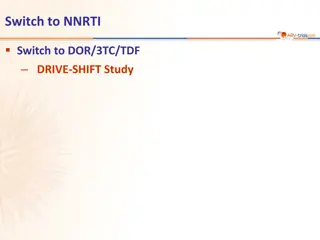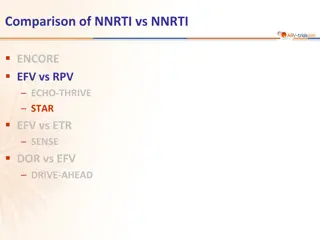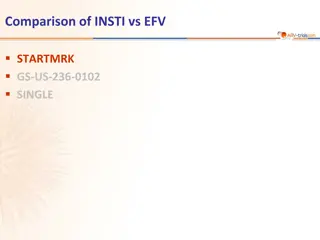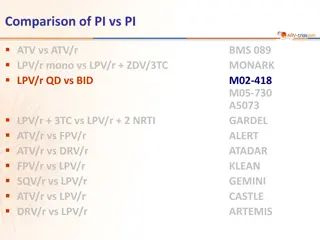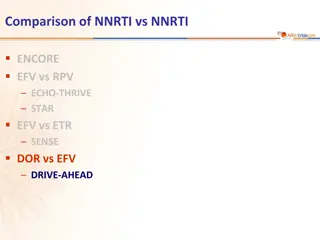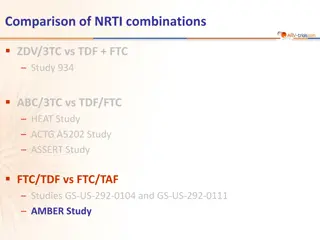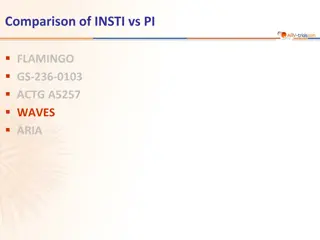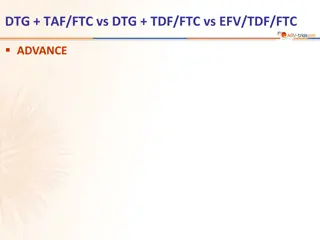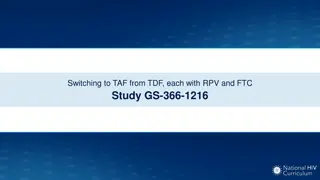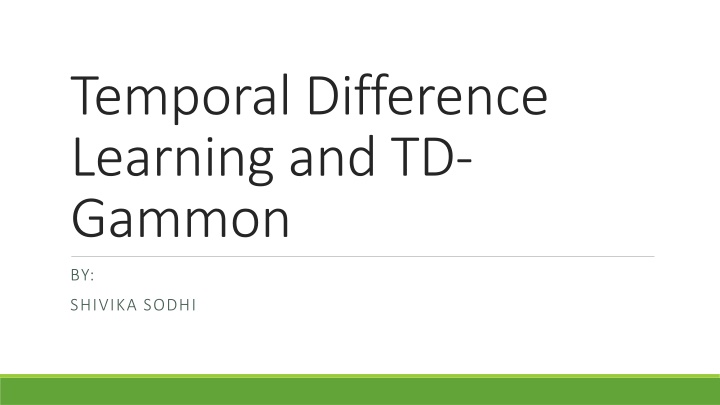
Temporal Difference Learning and TD-Gammon: Advancements in Reinforcement Learning
Explore TD-Gammon, a neural network that learns backgammon by self-play, uncovering novel approaches in reinforcement learning. Understand the benefits of reinforcement learning, challenges like temporal credit assignment, and advancements in nonlinear function approximation methods like Temporal Difference (TD) Learning.
Download Presentation

Please find below an Image/Link to download the presentation.
The content on the website is provided AS IS for your information and personal use only. It may not be sold, licensed, or shared on other websites without obtaining consent from the author. If you encounter any issues during the download, it is possible that the publisher has removed the file from their server.
You are allowed to download the files provided on this website for personal or commercial use, subject to the condition that they are used lawfully. All files are the property of their respective owners.
The content on the website is provided AS IS for your information and personal use only. It may not be sold, licensed, or shared on other websites without obtaining consent from the author.
E N D
Presentation Transcript
Temporal Difference Learning and TD- Gammon BY: SHIVIKA SODHI
INTRODUCTION TD-Gammon is a game-learning program It is a neural network that trains itself to be an evaluation function for the game of backgammon by playing against itself and learning from the outcome Purpose: Explore some exciting new ideas and approached to traditional problems in the field of reinforcement learning
Reinforcement Learning The learning agent observes an input state or input pattern, produces an action/output /control signal and then received a reward/reinforcement feedback signal from the environment indicating how good/bad its output was Goal of learning: Generate the optimal actions leading to maximal reward. In many cases, reward is delayed, then Learner needs to solve Temporal credit assignment problem (figure out ways to apportion credit and blame to various inputs/outputs)
Advantages and drawbacks Why reinforcement learning? - Because the learner is able to learn on its own, without the aid of an intelligent teacher from its own experience at attempting to perform a task - In supervised learning, a teacher signal is required that explicitly tells the learner what the correct output is for every input pattern Problems: - In reinforcement learning with delay, the temporal credit assignment aspect of the problem is difficult - They have been limited to learning lookup tables or linear evaluation function
Developments in Reinforcement Learning Development of a wide variety of novel nonlinear function approximation schemes like decision trees, localized basis functions, spline-fitting schemes and multilayer perceptions Development of a class of methods for approaching the temporal credit assignment problem, Temporal Difference (TD): - Learning is based on the difference between temporally successive predictions (make the learner s current prediction for current input pattern more closely match the next prediction at next time step)
Features of TD() (multilayer neural networks) A heuristic error signal is defined at every time step, based on the difference between two successive predictions, that drives the learning Given that a prediction error has been detected at a given time step, there is an exponentially decaying feedback of the error in time,so that previous estimates are corrected too. (time scale of the exponential delay is governed by ) TD TD- -Gammon was designed to Gammon was designed to: - Explore the capability of multilayer neural networks trained by YD( ) - Provide a detailed comparison of the TD learning approach with the alternative approach of supervised learning on a corpus of expert-labeled exemplars (Neurogammon)
Backgammon Backgammon is a two player game, played on one-dimensional track Players take turns rolling dice and moving their checkers in opposite direction along the track as allowed by dice roll Winner: 1stperson to move all his checkers all the way forward and off his end of the board Winning a gammon: the player wins double-stake if the opponent hasn t taken any checkers off Backgammon: the player wins triple-stake if the opponent hasn t taken any checkers off and has checkers in far most quadrant
Complexity in the Game of Backgammon The 1-D racing nature of the game is made more complex by 2 factors 1. It is possible to land on, or hit a single opponent checker (called blot ) and send it all the way back to the far end of board. The blot must re-enter the board before other checkers can be moved 2. It is possible to form blocking structures that impede the forward progress of the opponent checkers
More complexity More complexity is introduced by using a doubling cube through which either player can offer to double the stakes of the game If the opponent accepts the double, he gets the right to make the next double, if he declines he fortifies the current stake Thus, the total number of points won at the end of the game is given by the current value of the doubling cube multiplied by: 1 for a regular win, 2 for a gammon, 3 for a backgammon 1 for a regular win, 2 for a gammon, 3 for a backgammon A doubling algorithm was added after TD-Gammon s training that makes decisions by feeding TD- Gammon s expected reward estimates into a doubling formula
Difficulties with Backgammon Programming a computer to play high-level backgammon is difficult In simple situations, we can design a program that plays perfectly via table look-up, but it isn t feasible for the full game due to a lot of possible states At each ply there are 21 dice combinations possible, with an average of about 20 legal moves per dice combination, resulting in a branching ratio of several hundred per ply. Hence brute feasible brute- -force forceisn t
Difficulties with Building human expertise Backgammon programs rely on heuristic positional judgement in the absence of exact tables and deep searches work closely with human experts, over a long period of time, to design a heuristic evaluation function that mimics as closely as possible the positional knowledge and judgment of the experts substantial gap between the positional judgment of the best humans and the ability of knowledge engineers or supervised learning programs to encapsulate that judgment in the form of a heuristic evaluation function. human expertise that s being emulated, will not make mistakes
MLP (multilayer perceptron) MLP is at the heart of TD-Gammon Its output is computed by a feed-forward flow of activation from the input nodes to the output nodes, passing through one or more layers of internal nodes called "hidden" nodes. Each of the connections in the network is parameterized by a real valued "weight."
MLP (multilayer perceptron) Each of the nodes in the network outputs a real number equal to a weighted linear sum of inputs feeding into it, followed by a nonlinear sigmoidal "squashing" operation that maps the total summed input into the unit interval. The nonlinearity of the squashing function enables the neural network to compute nonlinear functions of its input, and the precise function implemented depends on the values of the weights. MLPs have robust approximation capabilities
TD-Gammons Learning Methodology Learning" in an MLP consists of applying a formula to change weights so that the function implemented by the network more closely approximates a desired target function. Globally optimal weights not feasible for large networks Locally optimal set of weight values found by Backpropagation
Training Procedure for TD-Gammon the network observes a sequence of board positions starting at the opening position and ending in a terminal position characterized by one side having removed all its checkers. The board positions are fed as input vectors x[1], x[2], . . . , x[f] to the neural network For each input pattern x[t] there is a neural network output vector Y[t] (four component vector) TD(lambda) algorithm is applied to change the network's weights. Formula for weight change:
Training Procedure for TD-Gammon At the end of each game, a final reward signal z is given, based on the outcome of the game. During training, the neural network is used to select moves for both sides and scores every possible legal move. the neural network is learning from the results of playing against itself (move with max expected outcome is selected)
Results of Training Networks learned elementary strategies during initial training (first few 1000) As the size of the network and amount of training experience increased, substantial improvements in performance were observed. Best performance: a network with 40 hidden units that was trained for a total of 200,000 games. networks appeared to be capable of automatic "feature discovery TD nets with the additional features, have surpassed Neurogammon
Results of Training Version 1.0 played 51 games against Robertie, Magriel, and Malcolm Davis, and achieved a net loss of 13 points, for an average loss rate of about one- quarter point per game. Version 2.0 of the program, had a 2-ply search algorithm, played against Kent Goulding, Kit Woolsey, Wilcox Snellings, Joe Sylvester, and Joe Russell, the program had a net loss of 7 points. Finally, version 2.1 achieved near-parity to Bill Robertie in a recent 40-game test session. Robertie actually trailed the entire session, and only in the very last game was he able to pull ahead for an extremely narrow 1-point victory
Example: split play With an opening roll of 2-1, 4-1, or 5-1, the choice of experts had always been to move a single checker from the 6 point to the 5 point, "slotting slotting Now the choice is split play, instead of slotting (opening slot was inferior to splitting the back checkers with 24-23)
Example 2 Sylvester, playing White, had rolled 4-4 and made the obvious-looking play of 8-4*, 8-4, 11-7, 11-7 TD-Gammon's recommendation is the surprising 8-4*, 8-4, 21-17, 21-17! To humans, the 21 point would be viewed as a better defensive anchor than the 17 point, and the 7 point would be viewed as a better blocking point than the 11 point. extensive rollout performed by TD-Gammon
Understanding the Learning Process By combining the TD approach to temporal credit assignment with the MLP architecture for nonlinear function approximation, surprising results have been obtained The TD self-play approach has greatly surpassed the alternative approach of supervised training on expert examples
Absolute Accuracy vs. Relative Accuracy TD-Gammon's equity estimates are commonly off by a tenth of a point or more (large error). Then how does it make master-level decisions? 1. When TD-Gammon makes a move decision, the errors made in evaluating each candidate play are not random, uncorrelated errors, but are in fact highly correlated (similarity-based generalization of the neural network) 2. In making a move decision, one has to choose between several candidate positions that are all very similar-looking. 3. Due to high degree of similarity, the neural network's equity estimates will all be off by approximately the same amount of absolute error. 4. Thus potentially large absolute errors cancel when comparing two candidate plays, leaving them ranked in proper order.
Stochastic Environment (2nd ingredient) Stochastic nature of the task coming from the random dice rolls. Stochastic dice rolls produce a degree of variability in the positions seen during training. As a result, the learner explores more of the state space than it would in the absence of such a stochastic noise source, and a possible consequence could be the discovery of new strategies and improved evaluations. In contrast, in deterministic games a system training by self-play could end up exploring only some very narrow portion of the state space, and might develop some horrible strategy that nevertheless gives self-consistent results when implemented against itself over the narrow range of positions that it produces.
Stochastic Environment In backgammon, terminal states come partly due to the dice rolls, and partly due to the fact that one can only move one's pieces in the forward direction. Checkers move backwards when they are hit by the opponent. These two factors imply that, even for random initial networks, games usually terminate in, at most, several thousand moves. On the other hand, in deterministic games it is possible that a random initial strategy might execute simple cycles that would last forever. In such cases the network could not learn, as it would never receive the final reward signal; special techniques would be required to prevent this from happening. Finally, non-deterministic games have the advantage that the target function one is trying to learn, the true expected outcome of a position given perfect play on both sides, is a real-valued function with a great deal of smoothness and continuity, that is, small changes in the position produce small changes in the probability of winning. In contrast, the true game-theoretic value function for deterministic games like chess is discrete (win, lose, draw) and presumably more discontinuous and harder to learn.
Learning Linear Concepts First (3rd ingredient) early elementary concepts can all be expressed by an evaluation function that is linear in the raw input variables. In TD learning process, the neural network first extracts the linear component of the evaluation function, while nonlinear concepts emerge later in learning. When the input variables encode the raw board information such as blots and points at particular locations, a linear function of those variables would express simple concepts such as "blots are bad" and "points are good. ." Such concepts are said to be context-insensitive, in that the evaluation function assigns a constant value to a particular feature, regardless of the context of the other features.
Example Ex, a constant value would be assigned to owning the 7 point, independent of the configuration of the rest of the board. On the other hand, an example of a context-sensitive concept that emerges later in learning is the notion that the value of the 7 point depends on where one's other checkers are located. Early in the game, when one has several checkers to be brought home, the 7 point is valuable as a blocking point and as a landing spot. On the other hand, if one is bearing in and all other checkers have been brought home, the 7 point then becomes a liability. linear function learned early on by the TD net gives a surprisingly strong strategy -- it is enormously better than the random initial strategy, and in fact is better than typical human beginner-level play. As such it may provide a useful starting point for subsequent further learning of nonlinear, context- sensitive concepts.
Conclusion Temporal difference learning: promising general-purpose technique for learning with delayed rewards. It can be applied both to prediction learning, to a combined prediction/control task in which control decisions are made by optimizing predicted outcome. Current version of the program: 2-ply Future scope: extended to 3-ply


